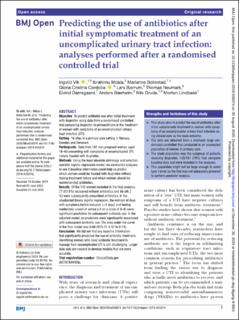| dc.contributor.author | Vik, Ingvild | |
| dc.contributor.author | Mdala, Ibrahimu | |
| dc.contributor.author | Bollestad, Marianne | |
| dc.contributor.author | Cordoba, Gloria | |
| dc.contributor.author | Bjerrum, Lars | |
| dc.contributor.author | Neumark, Thomas | |
| dc.contributor.author | Damsgaard, Eivind | |
| dc.contributor.author | Baerheim, Anders | |
| dc.contributor.author | Grude, Nils | |
| dc.contributor.author | Lindbæk, Morten | |
| dc.date.accessioned | 2021-07-07T08:14:13Z | |
| dc.date.available | 2021-07-07T08:14:13Z | |
| dc.date.created | 2020-09-14T12:45:15Z | |
| dc.date.issued | 2020 | |
| dc.Published | BMJ Open. 2020, 10:e035074 (8), 1-8. | |
| dc.identifier.issn | 2044-6055 | |
| dc.identifier.uri | https://hdl.handle.net/11250/2763664 | |
| dc.description.abstract | Objective To predict antibiotic use after initial treatment with ibuprofen using data from a randomised controlled trial comparing ibuprofen to pivmecillinam in the treatment of women with symptoms of an uncomplicated urinary tract infection (UTI). Setting 16 sites in a primary care setting in Norway, Sweden and Denmark. Participants Data from 181 non-pregnant women aged 18–60 presenting with symptoms of uncomplicated UTI, initially treated with ibuprofen. Methods Using the least absolute shrinkage and selection operator logistic regression model, we conducted analyses to see if baseline information could help us predict which women could be treated with ibuprofen without risking treatment failure and which women should be recommended antibiotics. Results Of the 143 women included in the final analysis, 77 (53.8%) recovered without antibiotics and 66 (46.2 %) were subsequently prescribed antibiotics. In the unadjusted binary logistic regression, the number of days with symptoms before inclusion (<3 days) and feeling moderately unwell or worse (≥4 on a scale of 0–6) were significant predictors for subsequent antibiotic use. In the adjusted model, no predictors were significantly associated with subsequent antibiotic use. The area under the curve of the final model was 0.66 (95% CI: 0.57 to 0.74). Conclusion We did not find any baseline information that significantly predicted the use of antibiotic treatment. Identifying women who need antibiotic treatment to manage their uncomplicated UTI is still challenging. Larger data sets are needed to develop models that are more accurate | en_US |
| dc.language.iso | eng | en_US |
| dc.publisher | BMJ | en_US |
| dc.rights | Navngivelse-Ikkekommersiell 4.0 Internasjonal | * |
| dc.rights.uri | http://creativecommons.org/licenses/by-nc/4.0/deed.no | * |
| dc.title | Predicting the use of antibiotics after initial symptomatic treatment of an uncomplicated urinary tract infection: Analyses performed after a randomised controlled trial | en_US |
| dc.type | Journal article | en_US |
| dc.type | Peer reviewed | en_US |
| dc.description.version | publishedVersion | en_US |
| dc.rights.holder | Copyright the authors | en_US |
| dc.source.articlenumber | e035074 | en_US |
| cristin.ispublished | true | |
| cristin.fulltext | original | |
| cristin.qualitycode | 1 | |
| dc.identifier.doi | 10.1136/bmjopen-2019-035074 | |
| dc.identifier.cristin | 1829690 | |
| dc.source.journal | BMJ Open | en_US |
| dc.source.40 | 10:e035074 | |
| dc.source.14 | 8 | |
| dc.identifier.citation | BMJ Open. 2020, 10, e035074. | en_US |
| dc.source.volume | 10 | en_US |

